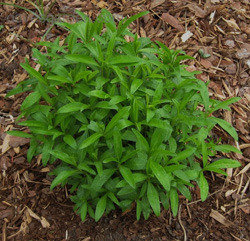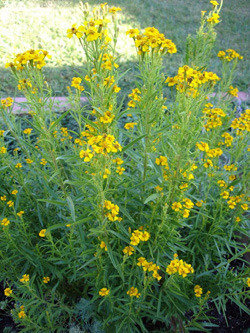Mexican mint marigold (Tagetes lucida) is an herb many people enjoy growing. Like many other herbs, it is not colorful or pretty year-round, but it makes up for this deficiency in many ways.

Mexican mint marigold has grown in my garden for years. Bushy plants contain many smooth, upright but unbranched stems. Linear to oblong glossy, medium green leaves line the stems. In fall, clusters of half-inch flowers with three to five golden-yellow petals (ray florets) bloom.
You may find it in garden centers labeled as Mexican or Spanish tarragon. Some folks know it as Texas tarragon, pericon, and sweet mace. Although perennial and reliable in Zones 8 – 11, it may be killed to the ground in winter, but it bounds back in spring. In regions north of Zone 8 it is grown as an annual or in containers and protected from freezes during the winter. In tropical regions such as the southern tips of Florida and Texas, it is evergreen.
When you see Mexican mint marigold in bloom, you will know it is a marigold even if it did not bloom in spring and summer like other members of the marigold family. Unlike other types of marigold that smell unpleasant to some people, this species smells so good that visitors to my garden are often treated to a sniff of the licorice scented leaves.
Growers should be forewarned that Mexican mint marigold is a prolific self-seeder. It took a few years for me to appreciate this because my plants are normally pruned after flowering to keep them neat. One year when I didn’t get around to this task, I found stems rooted where they lay on the ground, and seeds that had fallen from the plant came up in abundance.
Small, open-ended capsules of seeds are formed, much like French and American marigolds. Seed capsules are easily removed by picking them off the plants when they are dry. Like other composite flowers, each seedhead contains many seeds which germinate readily when they come in contact with soil. Propagation is also easy from stem cuttings and from division of mature plants. Mexican mint marigold is usually available at garden club plant sales. Customers pay the nondescript plants little attention until they get a sniff of the leaves, after which they sell out quickly.

Mexican mint marigold is sometimes marketed in the American South as French tarragon (
Artemisia dracunculus var.
sativa). Southerners do not argue about this, because they know that true tarragon does not grow well in the heat and humidity of Southern summers. Mexican mint marigold makes an excellent substitute for this licorice flavored herb even though it is a little stronger than French tarragon and has more of an anise flavor. The pretty yellow flowers can be picked and used in fresh green salads. A few leaves perk up a pot of chicken soup. Remoulade, tartar and bearnaise sauces make use of this seasoning, as does French salad dressing. It is tasty in herbal vinegars, and the leaves can be used for a soothing, aromatic herbal tea.
The fall blooms of Mexican mint marigold are attractive in perennial borders and herb gardens alike. Shiny leaves and little golden flowers are at their best when many other perennials have passed their prime. Growing to 18-30 inches tall, the half-hardy, semi-woody subshrub grows best in well-drained soil in sun or part sun. Once established it is fairly drought tolerant.
If you have never grown this herb, spring would be a good time to sow a few seeds. You may be as delighted as visitors to my garden are when they smell a crushed leaf of this fragrant herb.






 Mexican mint marigold has grown in my garden for years. Bushy plants contain many smooth, upright but unbranched stems. Linear to oblong glossy, medium green leaves line the stems. In fall, clusters of half-inch flowers with three to five golden-yellow petals (ray florets) bloom.
Mexican mint marigold has grown in my garden for years. Bushy plants contain many smooth, upright but unbranched stems. Linear to oblong glossy, medium green leaves line the stems. In fall, clusters of half-inch flowers with three to five golden-yellow petals (ray florets) bloom.  Mexican mint marigold is sometimes marketed in the American South as French tarragon (Artemisia dracunculus var. sativa). Southerners do not argue about this, because they know that true tarragon does not grow well in the heat and humidity of Southern summers. Mexican mint marigold makes an excellent substitute for this licorice flavored herb even though it is a little stronger than French tarragon and has more of an anise flavor. The pretty yellow flowers can be picked and used in fresh green salads. A few leaves perk up a pot of chicken soup. Remoulade, tartar and bearnaise sauces make use of this seasoning, as does French salad dressing. It is tasty in herbal vinegars, and the leaves can be used for a soothing, aromatic herbal tea.
Mexican mint marigold is sometimes marketed in the American South as French tarragon (Artemisia dracunculus var. sativa). Southerners do not argue about this, because they know that true tarragon does not grow well in the heat and humidity of Southern summers. Mexican mint marigold makes an excellent substitute for this licorice flavored herb even though it is a little stronger than French tarragon and has more of an anise flavor. The pretty yellow flowers can be picked and used in fresh green salads. A few leaves perk up a pot of chicken soup. Remoulade, tartar and bearnaise sauces make use of this seasoning, as does French salad dressing. It is tasty in herbal vinegars, and the leaves can be used for a soothing, aromatic herbal tea.